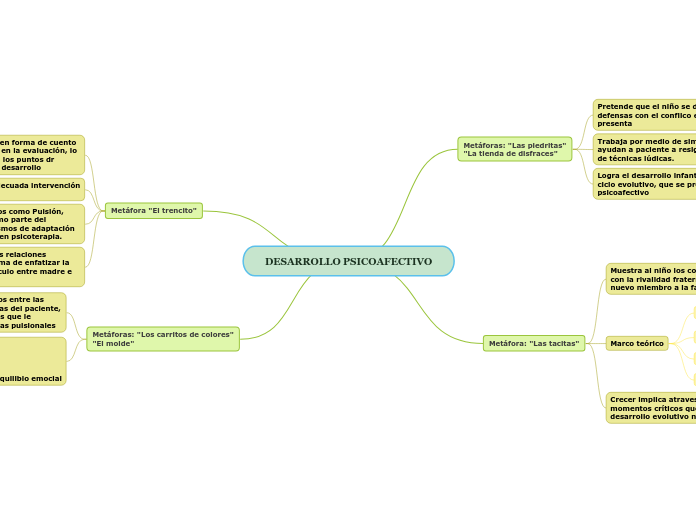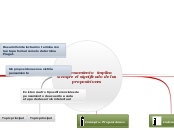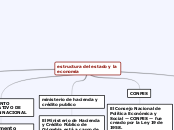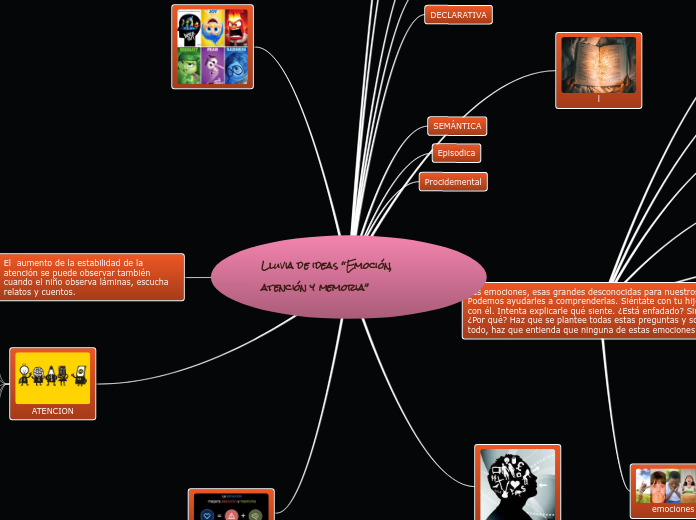DESARROLLO PSICOAFECTIVO
Metáforas: "Los carritos de colores"
"El molde"
Se base en el:
Ello
Yo
Superyo
Buscando el equilibio emocial
Busca esclarecer los conflictos entre las diferentes instancias psíquicas del paciente, con herramientas conscientes que le permiten lidear con las fuerzas pulsionales
Metáfora "El trencito"
There are four Future tenses:
- Future Simple ('with Will' and 'with Going to')
- Future Continuous
- Future Perfect Simple
- Future Perfect Continuous
Busca el equilibrio en las relaciones objetales, como una forma de enfatizar la importancia de este vínculo entre madre e hijo.
Future Perfect Simple is used for:
- an action that will continue up until a point in the future
- an action that finishes just before another time or action in the future
Some adverbs used with Past Perfect Continuous for future actions:
- for
- since
- next week
- next month
- next year
Desde la teoría del apego
Ulitiza conceptos teóricos como Pulsión, Fijación y Regresión como parte del abordaje de los mecanismos de adaptación que se pueden trabajar en psicoterapia.
Future Perfect Simple is used for:
- an action that will be finished by a particular time in the future
- an action that starts before and continues up to another action or time in the future
- an action that will finish before a certain time in the future, but it is not known exactly when
Adverb used with Future Continuous:
- tomorrow (e.g. tomorrow by 7)
Ficha técnica, para la adecuada intervención y manejo en la sesión
Future Continuous is used:
- for an action that is likely to happen in the future and continue for an expected length of time
- for an action that will be in progress at some point in the future
- for action verbs (e.g. running)
- for predictions about future events
Adverb used with Future Continuous:
- tomorrow (e.g. tomorrow at 5 o'clock)
Su objetivo es devolver en forma de cuento la información obtenida en la evaluación, lo cual esta relacinado con los puntos dr fijación en la etapas del desarrollo
Future Simple is used:
- to predict an event in the future
- to invite
- to give orders
- to express willingness
- for actions that have not yet occurred but that will occur at a future date
Metáfora: "Las tacitas"
There are four Past tenses:
- Past Simple
- Past Continuous
- Past Perfect Simple
- Past Perfect Continuous
Crecer implica atravesar una serie de momentos críticos que hacen parte del desarrollo evolutivo normal.
Past Perfect Simple is used for:
- an action that began in the past and is still going on at the moment of speaking
- an action that continued before and after another action
- a change of mind
- an action happening repeatedly in the past
The Past Perfect tense is not normally used alone. It is used to denote the earlier of two past actions. We use Past Simple for the latter action.
Some adverbs used with Past Perfect Simple:
- already, before, ever, never
- once, twice, yet
- just, up to then
- for, since
Marco teórico
Past Continuous is used for:
- an action that happened before another action in the past
- an action that started in the past and continued up to a given time in the past
- an action done several times up to a point in the past and continued to do after that point
- an action that happened in the past but is important at the time of reporting
Some adverbs used with Past Continuous:
- always, only, never, ever, still, just
Los celos
El hijo único
Structure:
Was/ were + Verb-ING?
e.g. Were you studying when she called?
Es el depositario de toda dedicación de los padres, lo cual supone que sea un niño caprichoso o egoísta.
Type in your own examples or you can also choose from the examples below.
Form of word "to be":
Was I being?Were you being?Was he/she/it being?Were we being?Were you being?Were they being?
Form of word "to have":
Was I having?Were you having?Was he/she/it having?Were we having?Were you having?Were they having?
Rivalidad fraterna
Structure:
Subject + wasn’t (was not)/ weren’t (were not) + Verb-ING
e.g. You were not studying when she called.
Rivalidad
Structure:
Subject + was/ were + Verb-ING
e.g. You were studying when she called.
Surge de la dinámica vincular, puede llegar a ser determinante, como la vivencia de un niño con la llegada de un hermanito
Type in your own examples or you can also choose from the examples below.
Form of verb 'to be':
I was beingYou were beingHe/She/It was beingWe were beingYou were beingThey were being
Form of verb 'to have':
I was havingYou were havingHe/She/It was havingWe were havingYou were havingThey were having
Muestra al niño los conflictos relacionados con la rivalidad fraterna en temas como un nuevo miembro a la familia.
Past simple expresses:
- an action that happened in the past and has no connection with the present
- an action that happened once in the past
- an action that happened regularly in the past
- an action that was true for some time in the past
- an event or action that already occurred
- an action that is finite - has both a starting and a stopping point
Some adverbs used with Past Simple:
- yesterday
- last month, last year
- ago (e.g. two days ago)
- in (e.g. in 1997)
- never, always, seldom, often, frequently, occasionally, once, twice
Metáforas: "Las piedritas"
"La tienda de disfraces"
There are four Present tenses:
- Present Simple
- Present Continuous
- Present Perfect
- Present Perfect Continuous
Logra el desarrollo infantil, luego de un ciclo evolutivo, que se presenta de manera psicoafectivo
Present Perfect is used for:
- an action that occurred at a time which is indefinite and has its effect on the subject
- an action that occurred many times and has the possibility to occur in the present/future
- an action that began in the past and is still going on in the present
Some adverbs used with Present Perfect:
- just
- already
- yet
- for
- never/ever
- up to now
Trabaja por medio de simbolismos que ayudan a paciente a resignificarse, a través de técnicas lúdicas.
Present Continuous is used to indicate the ongoing time (now).
Some adverbs used with Present Continuous:
- now, right now
- at this moment
- at the moment
- continually
- perpetually
- this year
- this season
- forever
Pretende que el niño se de cuenta de sus defensas con el conflico emocional que presenta
Present Simple is used for:
- habits
- general truths
- repeated actions of events
- fixed arrangements/timetables
- feelings/opinions/beliefs
- instructions.
Some adverbs used with Present Simple:
- always
- usually
- seldom
- never
- sometimes
- often
- frequently, generally
- habitually, occasionally
- once, twice









